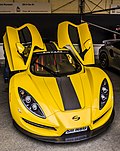The SIN R1 is a sports car made by Bulgarian manufacturer SIN Cars.
Background
Rosen Daskalov, the founder of SIN Cars & former racing driver, was working with a British business partner in the United Kingdom in 2012. After disagreements they split and Daskalov moved the company to his hometown and continued developing the R1.[1]
Specifications
The R1 features an FIA-certified tube frame construction, carbon fiber body and an active rear spoiler. It came with 3 engine choices – LS3 (6.2-liter N/A V8), LS7 (7.0-liter N/A V8) and an LS9 (6.2-liter supercharged V8). The transmission was a 6-speed manual. The car weighs just 1,250 kg (2,760 lb) and has a top speed of 300 km/h (186 mph).
The dimensions are L x W x H: 4,830 mm (190 in) x 2,000 mm (79 in) x 1,285 mm (50.6 in), with a wheelbase of 2,760 mm (109 in).The R1 series includes 3 models (450, 550 & 650) for road and 2 models (VTX & GT4) for track. The first R1 was revealed in track-only prototype form in 2013 at the Autosport International show. In 2014, a road-going prototype was shown. The R1 will be produced no more than 20 units annually. It is built around a strong, heavy and relatively easy-to-make tubular spaceframe chassis rather than a carbon fiber monocoque. Nonetheless the car weighs only 1,250 kg (2,760 lb).[2]
The 3 engines are a GM LS-based (6.2-liter N/A V8, 7.0-liter N/A V8 & 6.2-liter supercharged V8) for choices.[3][4] The 7.0-liter naturally aspirated engine has its pistons and bearings replaced with high-performance items. A dry sump lubrication system is better fitted for track driving, which means the engine can be positioned lower in the chassis – and it uses a bespoke, part-titanium exhaust.
The bodywork is all carbon and the rear wing is active. The brakes are supplied by AP Racing and the dampers by Öhlins. It has double wishbone suspension all around with in-board mounted springs and dampers. A sequential paddleshift gearbox and a traditional six-speed manual can be chosen, and the car has a limited-slip differential.[5]
-
Sin R1 at the Goodwood Festival of Speed 2014
-
Blancpain Endurance Series - Lamborghini Blancpain Super Trofeo - F. Renault 2.0 NEC - Competition102 GT4 European Series - Autodromo Nazionale di Monza in 2016
-
Sin R1 550 Hybrid at Geneva Motorshow 2018
Specifications[6]
| engine | displacement | bore/stroke | compression | induction | hp(kw)/rpm | torque Nm(lb·ft) | 0–100 km/h (0-62 mph) |
|---|---|---|---|---|---|---|---|
| Type R | 2,330 cc (2.4L; 175.0 cu in) | 2.60 in (220 mm) bore and 4.23 in (100mm) stroke | 11.9:1 | Turbocharger | 999 bhp(876 kW)/10000 | 675(324 lb•ft) | 2.9 sec |
| LS3 | 6,162 cc (6.162 L; 376.0 cu in) | 4.06 in (103 mm) bore and 3.62 in (92mm) stroke | 10.7:1 | N/A | 450 bhp(335 kW)/5900 | 585(424 lb·ft) | 3.9 sec |
| LS7 | 7,011 cc (7.011 L; 427.8 cu in) | 4.125in (104.775mm) bore and 4.00in (101.6mm) stroke | 11.1:1 | N/A | 530 bhp(395 kW)/6300 | 650(452 lb·ft) | 3.5 sec |
| LS9 | 6,162 cc (6.162 L; 376.0 cu in) | 4.06 in (103 mm) bore and 3.62 in (92 mm) stroke | 9.1:1 | supercharged | 650 bhp(484 kW)/6300 | 820(604 lb·ft) | 3.0 sec |
References
- ^ Karsten. "Goodwood 2013: SIN R1". Autogespot. Retrieved 2023-02-09.
- ^ Darren Moss. "Sin R1 sports car on sale for £145,000". Autocar. Retrieved 2023-02-09.
- ^ Viknesh Vijayenthiran. "Corvette-Powered Sin R1 Road Car Enters Production: Video". Motor Authority. Retrieved 2023-02-09.
- ^ Christopher Smith. "Sin R1 550 Live From Geneva Motor Show". Motor1. Retrieved 2023-02-09.
- ^ Dan Prosser. "Sin R1 review: Bulgaria's 'Vette-engined supercar driven". Top Gear. Retrieved 2023-02-09.
- ^ Máté Petrány. "The Sin R1 GT Is What A Lotus Exige Would Be With An LS3 V8". Jalopnik. Retrieved 2017-01-09.
External links












You must be logged in to post a comment.